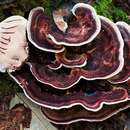ar
الأسماء في صفحات التنقل


Nigroporus is a genus of poroid fungi in the family Steccherinaceae.[1] The genus was circumscribed by American mycologist William Alphonso Murrill in 1905.[2] Nigroporus has a pantropical distribution.[3] The genus name combines the Latin word niger ("black") with the Ancient Greek word πόρος ("pore").[4]
The fruit bodies of Nigroporus fungi are annual to perennial. Their form ranges from pileate (with a cap) to crust-like. When a cap is present, it is scrupose (rough with very small hard points) to smooth, and sometimes with concentric zones. The colour is greyish-blue, vinaceous-brown to pink or violet. The pore surface has the same colours as the cap; pores are usually small and round to angular. The context is vinaceous brown to pink and purplish.[3]
The hyphal system is dimitic, meaning it contains both generative and skeletal hyphae. The generative hyphae have clamp connections; the skeletal hyphae are brownish, and thick-walled to solid. There are no cystidia in the hymenium. The spores are mostly small, with their longest dimension typically less than 5 µm. They are smooth and thin-walled, hyaline (translucent), with an allantoid (long with rounded ends) to broadly ellipsoid shape.[3]
Nigroporus is a genus of poroid fungi in the family Steccherinaceae. The genus was circumscribed by American mycologist William Alphonso Murrill in 1905. Nigroporus has a pantropical distribution. The genus name combines the Latin word niger ("black") with the Ancient Greek word πόρος ("pore").